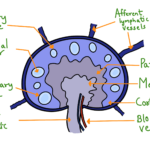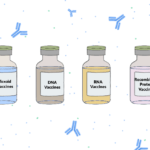As discussed in previous articles, the Agrobacterium-mediated transformation of plants is the most widely used technique for plant transformation. In this article, we will discuss the technique in detail.
Agrobacterium is a naturally occurring, Gram-negative soil bacterium with two species in abundance. The two species are, Agrobacterium tumifaciens and Agrobacterium rhizogens. A. tumefaciens is known to cause a ‘Crown gall disease’ in plants which results in tumor formation on the specific parts of the plant. The disease is caused due to the integration of the specific sequence of DNA known as T-DNA from a specific plasmid that is present in A.tumifaciens. The plasmid is known as Tumor inducing plasmid or simply Ti-plasmid. Similarly, A.rhizogens is also responsible for a disease in plants known as hairy root disease. The disease is caused due to the integration of specific DNA from a plasmid in A.rhizogens known as Root inducing plasmid or Ri-plasmid. This property of Agrobacterium to insert its plasmid DNA in the host’s nuclear genome is exploited in detail by scientists to find a new technique of plant transformation.
The Ti-plasmid
Naturally, the Ti plasmid of A.tumifaciens is a large plasmid of about 200kbp. The plasmid consists of a T-DNA known as transfer DNA. T-DNA is transferred in plant cells. T-DNA is flanked by two border sequences known as the Left border sequence (LB) and Right border sequence (RB). The border sequences are 25bp direct repeat sequences. LB and RB do not get transferred in plant cells but are crucial for the transfer process. T-DNA consists of genes for the synthesis of phytohormones auxins and cytokinins. The genes are present for the overproduction of phytohormones at the site of infection which is necessary for plant cell proliferation leading to tumor development. T-DNA also has genes necessary for the production of opines such as nopaline, agropine, and octopine. The opines are produced in plant cells and are catabolized by Agrobacterium as a carbon and nitrogen source. Apart from T-DNA and border sequences, Ti-plasmid has virulence genes (vir genes) which are required for the transformation of T-DNA into plant cells. Vir genes are divided into eight classes which are termed from Vir A to Vir H. Ti-plasmid also has ori sequence and opine catabolism genes. Note that only the T-DNA part of the plasmid is transferred into plant cells other genes are required for the process.

The recombinant Ti-plasmid for plant transformation
As we have discussed earlier, only the T-DNA is transferred in plant cells, to design a recombinant Ti-plasmid with a gene of interest to transform plant cells, the gene of interest is inserted between the LB and RB part of the Ti-plasmid by deleting the T-DNA. This is done because the genes present in the naturally occurring T-DNA are not necessary for the transfer process. Sometimes for the selection process, a strong selectable marker gene is also inserted between LB and RB along with the gene of interest. The recombinant Ti-plasmid is commonly called a transformation vector. There are two types of transformation vectors: Cis-vectors and Trans-vectors. In cis-vectors, the gene of interest and the vir genes required for the transformation are present on the same vector. The cis-vectors are known as co-integrative vectors. In trans-vectors, due to the larger size of the gene of interest, a new plasmid is employed containing the vir genes along with the recombinant Ti-plasmid. This new plasmid with vir genes is termed as ‘helper plasmid’. trans vectors are also termed as ‘binary vectors’.


The process of transformation
Once the recombinant Ti-plasmid is ready, agrobacterial cells are transformed with the recombinant plasmid using methods like chemical transformation and electroporation. For the plant cells to get transformed, there must be very close contact between plant cells and bacterial cells. This is achieved by dipping the young callus of the plant in a broth containing agrobacterial cells. In new methods, a pressure pump can be employed to facilitate the contact between plant cells and agrobacterial cells. Acetosyringone is a chemical that is employed to facilitate the transformation as acetosyringone induces vir genes required for transformation. In the process of transformation, agrobacterium integrates the gene of interest at a random position in the plant’s nuclear genome. Selection is done using selectable marker genes to check the transformed cells.
Advantages of agrobacterial transformation of plant cells
1. The process is a natural mechanism hence it does not require sophisticated instruments.
2. As the insertion is a single copy insertion of the gene of interest, silencing due to multiple copy number is very low.
3. There is no insertion size limit for the gene of interest.
4. The percent of transformed plants is higher in this method.



